The death of renowned art dealer Tim Klingender,an authority in Aboriginal art,in a boating accident on his beloved Sydney coast has devastated the Australian and international art worlds and his family and multitudinous friends.
The tragic accident near Sydney Harbour’s notorious heads on the morning of July 20 also took the life of his friend,,a 51-year-old father of three and one of the many who would accompany Klingender over years of enthusiastically frequent fishing expeditions.
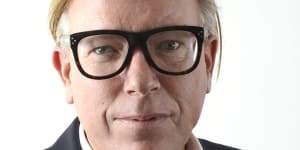
Tim Klingender,art gallery director and senior consultant in Australian Art to Sotheby’s.Supplied
Klingender derived stupendous joy from fishing and whale-watching,something his Instagram account colourfully chronicles,including the 67 different fish species he’d hooked in the harbour over the briny years.
That feed,fizzing with fish and the joy of life,also shows a whale breaching during a recent outing with his daughters. He caught a tuna on the way home.
The reverberating shock and sadness and the panoply of accolades reflect the respect Klingender,59,commanded for his knowledge and for the decency and conviction with which he treated artists.
He was widely recognised as a founder of the global market for Aboriginal art. His pioneering was pivotal.
His professionalism was unimpeachable,his personal presence infectious. He was an eloquent and elegantbon vivant.
For three decades,Klingender took magnificent works afar,helping make the world aware of the compelling beauty and power of Indigenous Australian art.
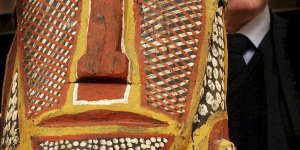
Klingender in 2010 with a work titled Bima,by artist Declan Apuatimi.Supplied
He established the Aboriginal art department at Sotheby’s in 1996 after starting at the auction house in the early 1990s,where he initially ran its contemporary art department.
As head of Sotheby’s Aboriginal art,Klingender created international interest,by touring selected works from upcoming Australian auctions in Paris,London and New York. Artists including Rover Thomas and Emily Kame Kngwarreye became revered throughout the world.
In 2009,he set up his own operation,Tim Klingender Fine Art.
He had an extensive list of international clients,and his authority and judgment earned trust and respect among artists,curators,collectors and colleagues alike. He was dedicated to supporting First Nations people,and instrumental in raising money for the Western Desert Dialysis Appeal. That funded Purple House,an Alice Springs-based health organisation.
He was also senior consultant to Bonhams auction house between 2011 and 2013,during which time he primed the high-profile sale of the Laverty Collection of Contemporary Australian Art by touring it in New York and London beforehand.
His many auctions enjoyed commercial and critical success. He created a fine and decent international secondary market not only because he was fine and decent,but because he had an exquisite eye. He has set a high standard,part of his legacy.
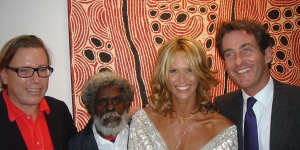
Klingender,John Mawurndjul,Elle McPherson and Tim Jefferies at the opening of the 2006 exhibition that raised money for the Western Desert Appeal.Sotheby’s
He continued consulting for Sotheby’s and ran a number of international sales with them. His shows in Australia and in New York,Paris and London were almost,without exception,of museum standard.
He detected heft. Recognised it,innately. In people and in art. And people recognised it in him. Anyone involved with Indigenous art would immediately consider him the “go-to” for his profound knowledge of such an ancient art form. When the National Gallery in Canberra and the National Gallery of Victoria needed to regularly value their Aboriginal art collections,they knew who to call.
John Albrecht,chairman of Australian auction house Leonard Joel,was quoted after the accident as saying Klingender “literally conceived and designed the ethical secondary market for Indigenous art in Australia”.
The founder of Sotheby’s in Australia,Robert Bleakley,was similarly declarative,telling a journal:“I don’t think there’s anyone who can step into the breach there.”
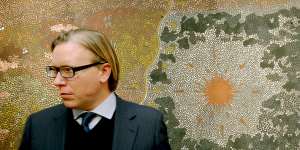
Klingender in 2007 with the Clifford Possum painting Warlugulong.Supplied
In a letter to Klingender’s wife Skye McCardle,Henry Howard-Sneyd,Sotheby’s chairman of Asian Art,Europe and Americas,wrote:“Tim became a big part of my reason for being so taken by the Australian market presence of our company … I know my life was enriched by knowing and working with him.”
Only weeks earlier,Klingender had been in New York to command Sotheby’s fourth auction of Aboriginal art.
On leaving New York he posted on his Instagram feed:“Such great art,energy,old friends and new friends every time … and now 26 years of having the responsibility and privilege to show some of the best Australian Indigenous art in a city like no other. Can’t wait to get home and head to sea.”
In the past few days,Klingender’s friend,art curator Hetti Perkins,admired that he was a “comet blazing through life”.
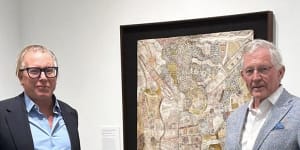
Klingender with John Wilkerson,a leading American collector of Aboriginal art,in New York in May.Supplied
She encapsulated what many felt. His voracious embrace of existence was infectious,his capacity for mirth prodigious,his generosity unstinting.
Klingender’s enchantment with art was fuelled by his studies at University of Melbourne,where he graduated in the mid-1980s.
As long ago as 2000,he assisted Perkins source paintings for the seminal exhibition Papunya Tula:Genesis and Genius at the Art Gallery of NSW. He was working with Perkins on a forthcoming retrospective of Kngwarreye’s work for the National Gallery of Australia.
The nature of the savage loss this month clashes with the spirit of this caring,gentle,inspiring man. Of Tim Klingender it can be truly stated that here was a person who made the world better and fairer.
It was a world he loved to explore,travelling extensively with his beloved family,even spending many months some years ago exploring Asia. Another exciting world tour was in the planning to celebrate his 60th birthday.
Klingender’s verve and kindness,his ethics and principles and his ceaseless curiosity were qualities also to be found in his parents,Joanna and Tony.
Klingender was an exceptional father,husband,brother,son and friend. The bond he had with his siblings has been noted by many for its colossal strength.
With many friends,he had bonds spanning decades. And he just kept making them everywhere he went,carefully promoting Aboriginal art.
He was,in his work,words,and ways a cultural leader. So much knowledge has been lost. It is irreplaceable.
Klingender was the most iconic influence on this sector of the international art market. Here was a unique,compelling melange of curiosity,intellect,substance and zest. What a grand memoir he might have written. And what a grand story he wrote with his days.
Tim Klingender is survived by wife Skye McCardle and their daughters Bay and Gala,and his siblings Jessica and Jonathan and their families.
Michael Short
The Morning Edition newsletter is our guide to the day’s most important and interesting stories,analysis and insights..